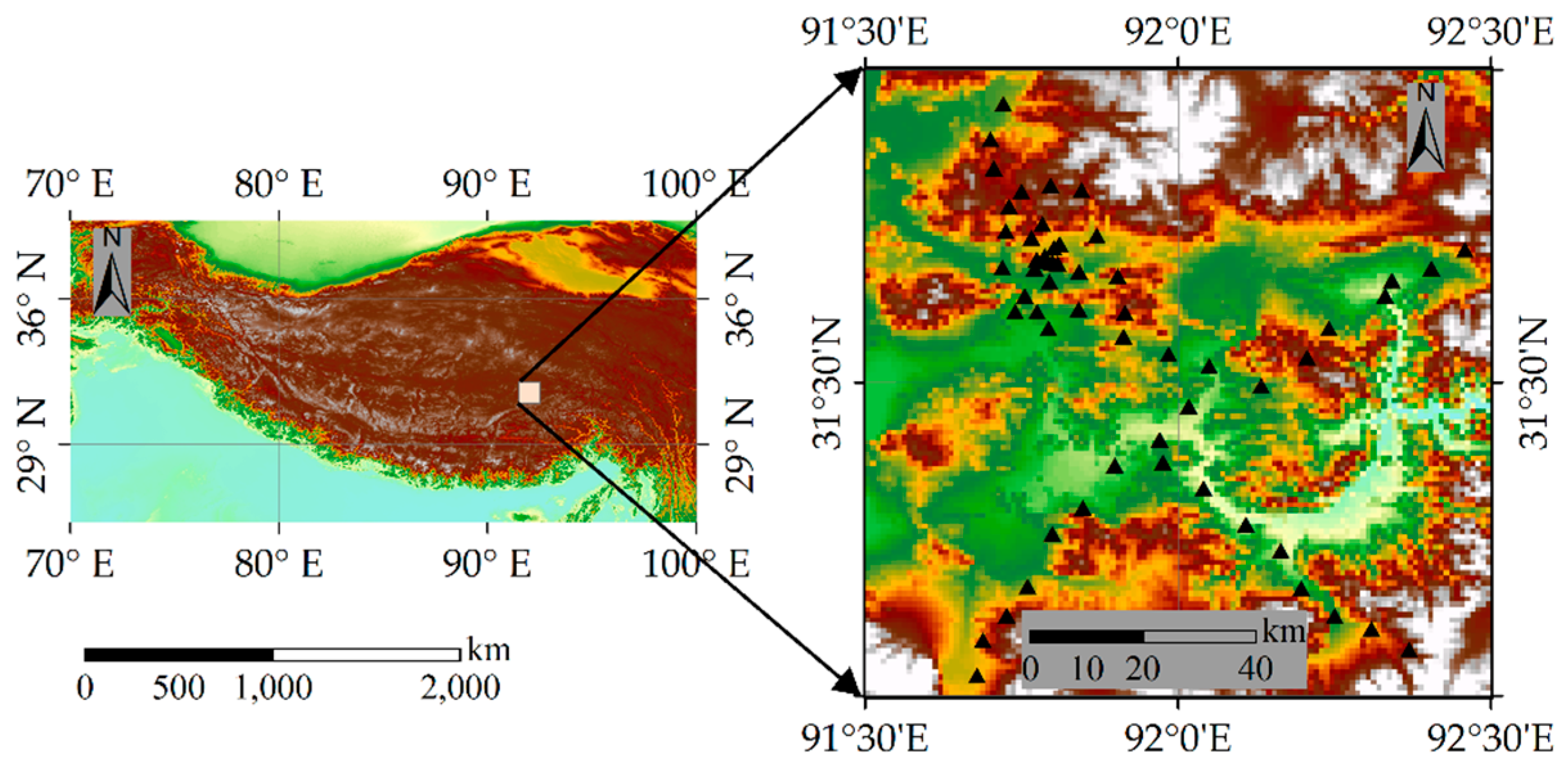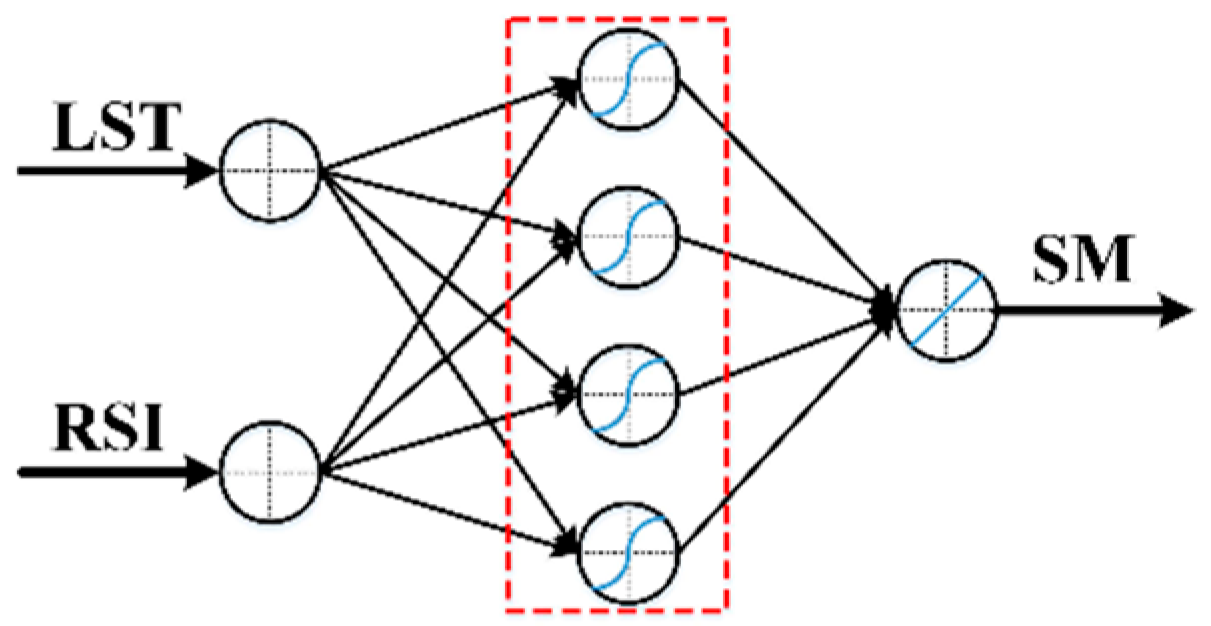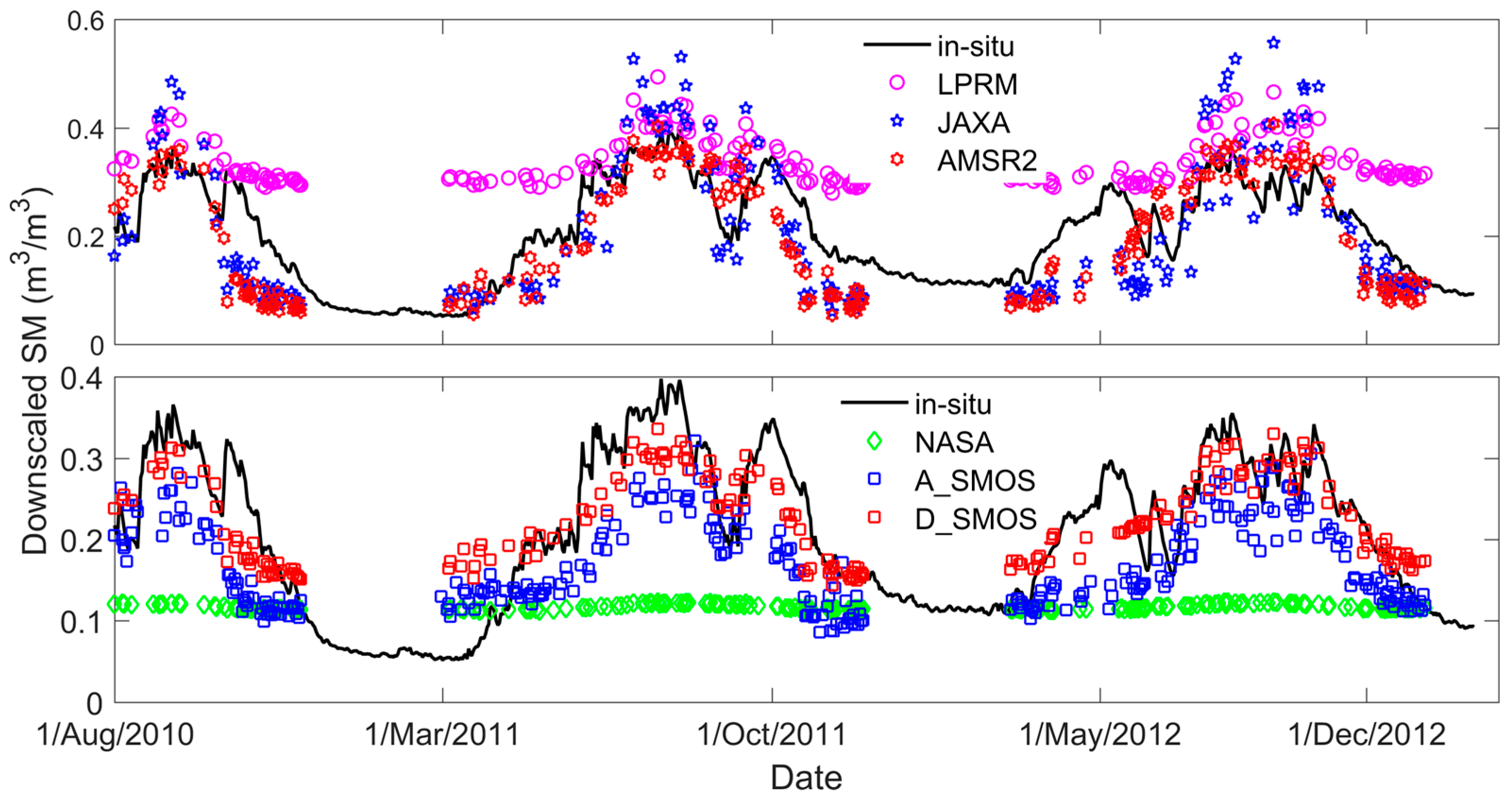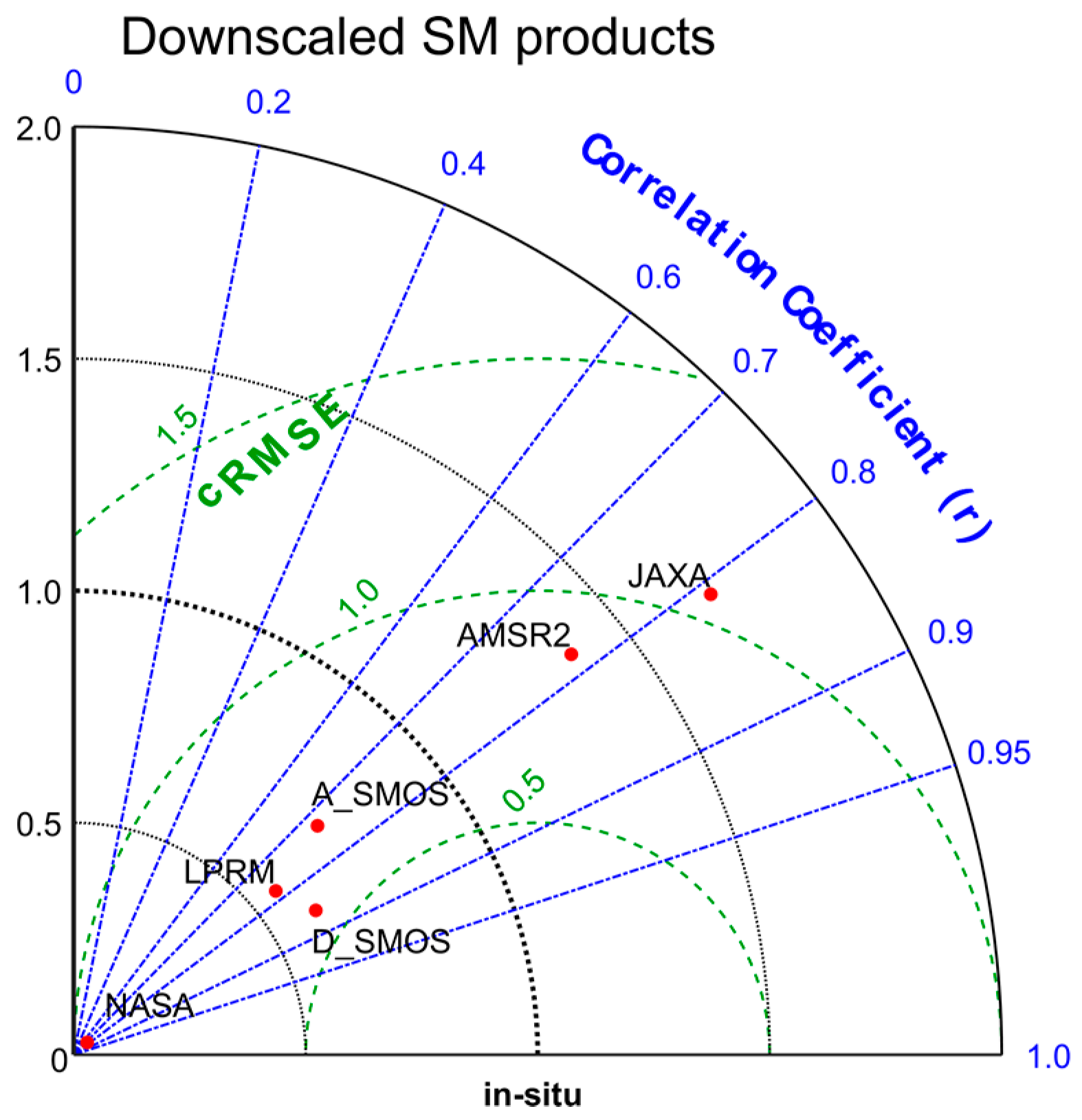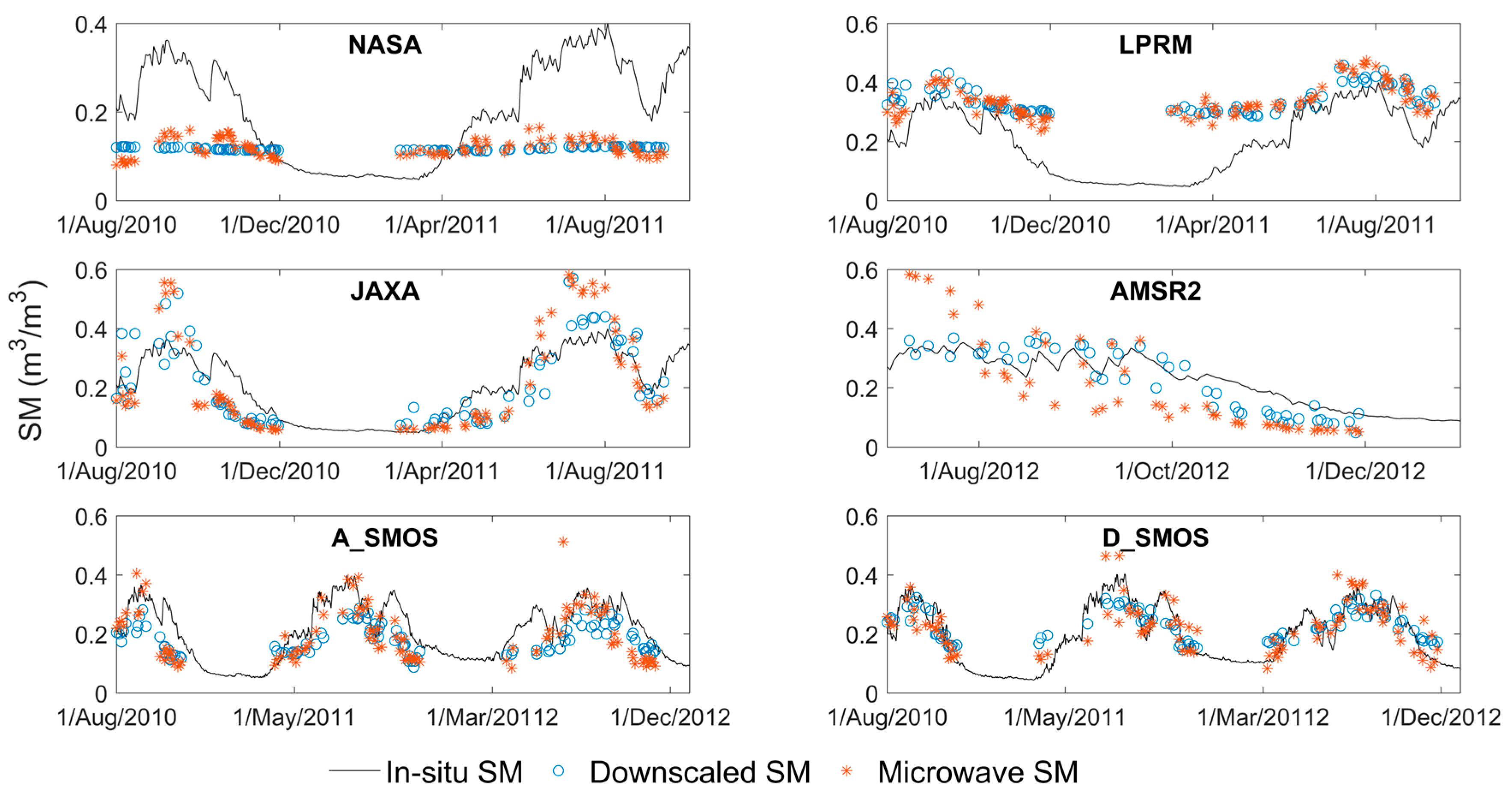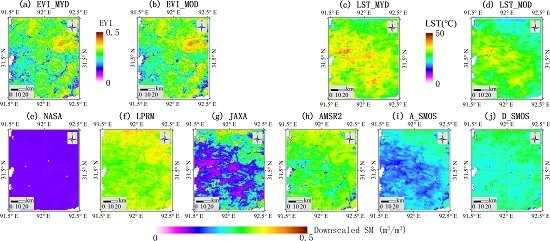1. Introduction
Over the past decades, various passive microwave satellites or sensors have been launched to measure soil moisture (SM) globally, with revisit cycles of two to three days, including the Advanced Microwave Scanning Radiometer–Earth Observing System (AMSR-E), the Soil Moisture and Ocean Salinity (SMOS) mission, the Advanced Microwave Scanning Radiometer-2 (AMSR2), and the Soil Moisture Active Passive (SMAP) mission. Except for the 9-km resolution of the SMAP SM product [
1], which is obtained by merging radiometer with radar data, the other instruments are characterized by a coarse spatial resolution (~25-km) [
2,
3]. Unfortunately, the radar instrument of SMAP broke down on 7 July 2015, which resulted in the terminated transmission of satellite-based SM observations at a spatial resolution finer than 10-km. These SM products can be insufficient for local or regional studies due to their coarse spatial resolution, where SM observations at a 1–10-km resolution are commonly required [
4]. Therefore, downscaling is needed to improve the spatial resolution for the effective application of passive microwave derived SM products. Different remote sensing data and auxiliary data are used for microwave SM product downscaling, such as optical/thermal infrared (OTI) remote sensing data [
4,
5,
6,
7,
8,
9,
10,
11,
12,
13], active microwave data [
1,
14,
15], and topographic, vegetation, and soil data [
16]. Among these supplementary datasets, OTI data are widely used for SM downscaling as they can be conveniently accessed and provide detailed land-surface contextual information [
11].
Traditionally, SM downscaling methods using OTI data are built upon the triangle framework [
17]. This framework is formed as a triangular or trapezoid distribution relating the land surface temperature (LST) and the normalized difference vegetation index (NDVI) within ‘wet’ and ‘dry’ edges, and the SM condition is a vital factor influencing the edges. Since Chauhan et al. [
5] first proposed a regression equation for improving the spatial variability of the Special Sensor Microwave Imager (SSM/I) SM by integrating the triangle-based SM downscaling method proposed by Carlson [
17] and the surface albedo, various microwave SM products (~25 km) have been downscaled using this method and revised versions [
6,
18,
19]. Piles et al. [
4] and Song et al. [
10] included microwave brightness temperature (Tb) and LST/NDVI data within the regression method to downscale SMOS and AMSR-E SM, respectively. Soil evaporative efficiency [
7,
8] derived from LST and NDVI data has also been proposed for SMOS SM downscaling; however, the requirement for many field-measured biophysical parameters limits the wide application of this semi-empirical model. Chen et al. [
12] proposed a new method based on OTI data to downscale SMAP SM from a 36-km to a 250-m scale and concluded that the method has a wide application scope through tests on SMAPEx-4/5 data.
To date, SM downscaling has mainly focused on the single microwave SM products derived from AMSR-E, SMOS, or SMAP products [
6,
10,
12,
20,
21]. Microwave SM products derived from different satellites have varied accuracies, which has been confirmed in many studies [
2,
3,
22,
23]. However, the accuracy differences between the different downscaled SM products are still not clear. Characterizing the accuracies of the different downscaled SM products will be of great value for both local and regional studies. High-accuracy SM data with high spatial information is needed for the improvement of weather prediction forecasting, drought assessment, eco-system monitoring, and water resources management. The evaluation of the different downscaled microwave SM products will help us to understand the difference between the downscaled SM products and will help researchers to choose appropriate downscaled SM products for use in further studies.
Zhao et al. [
24] and Wang et al. [
11] compared different SM downscaling methods over Mqau on the Tibetan Plateau. This study revealed that the accuracies of the methods proposed by Merlin et al. [
8] and Piles et al. [
4] were comparable with triangle-based SM downscaling over the Tibetan Plateau. The triangle-based SM downscaling method is easy to implement, relying on the relationship between SM and LST/NDVI, and the downscaled SM has no blocky effect. However, the relationship between SM and LST/NDVI is primarily formulated via a regression equation, which may not be capable of fully revealing the complicated nonlinearity of the relationship. For strong nonlinear fitting, the back-propagation neural network (BPNN) can simulate the relationship effectively. In addition, remote sensing indexes (RSIs) [
11,
19] calculated by surface reflectance data can act as the NDVI for SM downscaling. Therefore, the utilization of the BPNN and an appropriate LST/RSI for SM downscaling may achieve better results.
In this research, multiple microwave SM products derived from AMSR-E, AMSR2 (together referred to as AMSR hereafter), and SMOS were downscaled by the BPNN and LST/RSI for the Tibetan Plateau. To choose the appropriate RSI for SM downscaling, five different RSIs derived from Moderate Resolution Imaging Spectro-radiometer (MODIS) surface reflectance data were investigated. In-situ SM data from the central Tibetan Plateau Soil Moisture/Temperature Monitoring Network (SMTMN), which is located at Naqu, were used to evaluate the multiple downscaled SM products. Therefore, the aims of this research were to evaluate the multiple BPNN-downscaled SM products over the SMTMN area from 1 August 2010 to 31 December 2012 and to examine the differences between microwave and downscaled SM products so as to analyze the discrepancies among the multiple downscaled SM products.
5. Discussion
In this research, we found that the EVI is the optimal RSI for SM downscaling. To investigate the reason for this, the
r between the RSI and SM at the microwave scale (microwave SM) and MODIS scale (in-situ SM) was calculated (
Table 6). The relationship between SM and LST/RSI is better simulated by the BPNN, with a higher
r between the SM and RSI at the microwave scale because of the reduced interference for training. Meanwhile, the BPNN-downscaled SM products obtain good results, with a higher
r between the SM and RSI at the MODIS scale, because of the higher-quality data for BPNN prediction. As shown in
Table 6, the
r of NDWI7 and NDWI6 is slightly higher than the
r of EVI and NDVI for the AMSR products at the microwave scale, and the
r of EVI is the highest for the SMOS products at both the microwave and MODIS scales (in bold). Overall, the relationship simulated by the BPNN with various RSIs is similar at the microwave scale because of the close
r between NDVI, EVI, and the three kinds of NDWI. For optimal results, the EVI should be chosen for the SM downscaling because the
r of the EVI is significantly higher than the
r of the other RSIs at the MODIS scale (
Table 6). As shown in
Figure 5, the first- and second-order regression downscaling based on LST/RSI obtains a comparable performance to the Choi and Hur method [
6], indicating the slight contribution of surface albedo to SM downscaling over the Tibetan Plateau. This is mainly a result of the very weak correlation between SM and surface albedo at the microwave and MODIS scales (
Table 6). Nevertheless, surface albedo added into the BPNN could further increase the downscaled performance, which will be tested in our future study.
Even though the original errors of the microwave SM products cannot be reduced by SM downscaling [
24], the temporal variations of the in-situ SM are well characterized by the downscaling, as indicated by the high
r between the BPNN-downscaled SM and the in-situ SM (>0.72) (
Table 4). In addition, the
r values of the downscaled SM products are less than 0.86 (
Table 4). This suggests that the SM downscaling using the BPNN and LST/EVI may have reached the limits of the method, as the method only takes into account the surface temperature and vegetation index [
38], without considering the soil temperature, evapotranspiration, surface roughness, vegetation structure, and other factors. The variability in SM is impacted by the variability in atmospheric conditions and land surface characteristics at different spatial scales. The relationship between SM and LST/RSI was assumed scale-invariant for SM downscaling at the microwave and MODIS scales. The scale effect for SM downscaling should be investigated in future studies.
It can be seen from
Figure 9 and
Table 5 that the SMOS points with a lower RMSE are closer to the in-situ curve, and the AMSR points with a higher RMSE deviate more from the in-situ curve, despite the good temporal variation (
r). As a result of the limited anti-interference ability of the BPNN, the BPNN cannot be well trained when there is a large RMSE around the observations. The less the RMSE, the more robust the trained BPNN. Therefore, a lower original RMSE for the SM products results in a higher downscaled
r (
Table 5) with the same MODIS inputs (LST/EVI) for AMSR (except AMSR2) and D_SMOS downscaling. It should be noted that the MODIS inputs are MYD_LST and MYD_EVI for AMSR and D_SMOS, while the MODIS inputs are MOD_LST and MOD_EVI for A_SMOS. Due to the lower RMSE of the SMOS products, the downscaled
r of SMOS should be higher than the downscaled
r of AMSR. However, the downscaled
r of A_SMOS is the poorest (
Figure 9 and
Table 5), which is mainly because the surface energy balance is more likely to be water-limited in the afternoon (AMSR and D_SMOS) and the LST is more tightly coupled to the SM than in the morning (A_SMOS) [
4]. Therefore, the SM downscaling relationship simulated by the BPNN and LST/EVI using morning MODIS LST would be worse than that using afternoon MODIS LST.
6. Conclusions
The evaluation of the multiple downscaled microwave SM products is of vital importance for both regional- and local-scale studies and applications. In this study, the BPNN was utilized for the SM downscaling as the BPNN can sufficiently simulate the nonlinear relationship between SM and LST/RSI. The SM products of three passive microwave satellites, i.e., AMSR-E, AMSR2, and SMOS, were downscaled from the microwave scale (25 km) to the MODIS scale (1 km). To select an appropriate RSI for the SM downscaling, various RSIs, including NDVI, EVI, and three kinds of NDWI, were investigated in this research. SM downscaling was implemented from 1 August 2010 to 31 December 2012, and the in-situ SM data from 56 stations of the SMTMN were used to evaluate the microwave and downscaled SM products over Naqu in the Central Tibetan Plateau.
The downscaling shows a number of differences between the different microwave SM products and LST/RSI combinations. The correlation coefficient (r) of the BPNN-downscaled SM is better than the regression-downscaled SM. However, the downscaled RMSE and bias are comparable between the BPNN downscaling and the regression downscaling for each microwave SM product. LST/EVI is the most suitable combination for SM downscaling, obtaining the maximum downscaled r among the LST/RSI combinations for the BPNN and most of the regression downscaling approaches. Based on the optimal SM downscaling combination, the differences between the various BPNN-downscaled SM products and the discrepancies between the microwave and BPNN-downscaled SM products were further investigated. The temporal variations of the multiple BPNN-downscaled SM products show a good consistency with the in-situ SM (r > 0.72). For the AMSR products (except AMSR2) and the descending node of SMOS, the original RMSE of each SM product results in a higher downscaled r. Among the six BPNN-downscaled SM products, the performance of the downscaled D_SMOS product is the best, with r = 0.859, RMSE = 0.052 m3/m3, and bias = −0.011 m3/m3. The BPNN-downscaled SM products are greatly dependent on the original microwave SM products, and the difference in temporal accuracy between the downscaled and microwave SM products is marginal. We conclude that the BPNN-downscaled SM products with a fine resolution could be widely used for both regional and local research.
